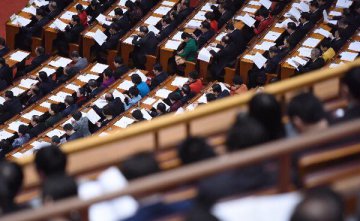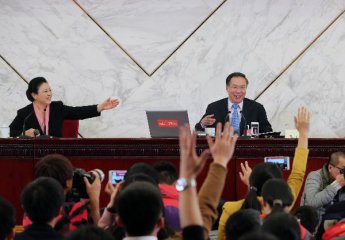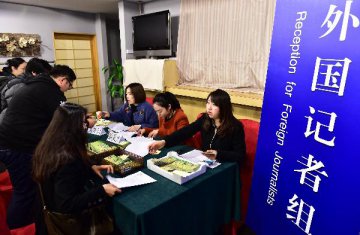
China's "two sessions" this year are presenting new and inspirational ideas for better realization of policy coordination, connectivity, unimpeded trade, financial integration and people-to-people bonds during the Belt and Road construction.
Policy coordination: integrate public policy service along Belt and Road Policy coordination ensures successful implementation of the Belt and Road Initiative.It is necessary for countries along the routes to extend sufficient exchanges and jointly formulate cooperative planning so as to form a community with mutual trust and benefit. With deep promotion of the Belt and Road Initiative, enterprises have accelerated their pace to make overseas investment and thus strongly appealed for policy coordination. "In order to further integrate public policy service along the routes of the Belt and Road, I suggest that China should establish an international information sharing platform," said Lv Jianzhong, a member of the 12th National Committee of the Chinese People's Political Consultative Conference (CPPCC).
Lv added that a smooth policy sharing channel can be forged via setting up different columns in the platform, including public policies, economic data and information disclosure. As a bridge linking governments and enterprises, international chambers of commerce should give a full display of their advantages to promote the implementation of Belt and Road projects, said Lv. In November 2015, China and Singapore rolled out China-Singapore (Chongqing) Demonstration Initiative on Strategic Connectivity.
By far, the two countries have conducted full communications on policies, laying a solid foundation for smooth promotion of the initiative. Tang Zongwei, a deputy to the 12th National People's Congress (NPC) and executive deputy director of Liangjiang Administrative Committee, introduced in a press conference that except for the coordination mechanism on a state basis, Chongqing Municipality, China's Ministry of Commerce (MOC) and Singapore's Ministry of Trade Industry have also formulated a cooperative mechanism. Moreover, Chongqing's municipal government has set up four special committees and an overall coordination office in this regard to ensure a smooth communication channel.
Connectivity: key transport channel construction accelerating Apparently, building railways, highways and air routes that link Chinese provinces with surrounding countries is vital to enhance infrastructure connectivity under the Belt and Road Initiative. Guangxi Zhuang Autonomous Region, a coastal locality in south China and Xinjiang Uygur Autonomous Region, an inland locality sitting in northwest China, can thus, given their special geological locations, play a key role in bettering transport connectivity with central Asia, south Asia, west Asia and the Europe.
Being a key section of the 21st Century Maritime Silk Road, China's Guangxi will seize the chance to build key transport channels and projects, in particular the Nanning-Pingxiang-Hanoi-Indo-China Peninsula railway, to form backbone railway networks and improve transport connectivity under the Belt and Road Initiative. Deputies from Xinjiang to the 12th NPC suggest China shall give priority to building the Kashgar to Khunjerab Pass railway to help related parities prepare for construction of the whole China-Pakistan railways. Besides, Lou Qinjian, a NPC deputy and governor of the People's Government of Shaanxi Province, said the province planned to open 9-10 more international air routes in 2016 after having rolled out nine ones in 2015.
Unimpeded Trade: linking FTZs at home and abroad As a critical objective of the Belt and Road Initiative, unimpeded trade is expected to contain such content as establishing free trade zones (FTZ) with related countries, especially those bordering China, so as to craft the "Belt and Road" market which features prosperous trade and business activities. Setting up FTZs with foreign countries is a nice choice but involves interests of multiple parties, which adds to the difficulty of their establishment. Under such circumstances, forging links between international FTZs and domestic pilot FTZs will be a better choice to consolidate cooperation between pilot FTZs at home and countries with which China have signed free trade agreements. For instance, China shall speed up talent team cultivation, create comprehensive economic and trade cooperation platforms and cross-border finance innovation platforms, and accelerate investment and trade facilitation to link domestic pilot FTZs with FTZs.
Meanwhile, taking advantage of the present trade channels, for instance, the "Yu-Xin-Ou" or Chongqing-Xinjiang-Europe railway, to build FTZs between China and countries alongside the rail line can save lots of efforts and at the same time significantly facilitate multilateral trade communication. Ma Zhongyuan, a deputy to the 12th NPC and adviser of Chongqing Municipal Government held China should start from trade, investment and customs clearance facilitation and research over founding FTZs similar to the China-ASEAN Free Trade Area with countries alongside the "Yu-Xin-Ou" transport channel to promote inter-country trade coordination. As Ma noted, the move could not only push ahead trade cooperation between different countries but also give central and west China-located businesses access to enjoy corresponding conveniences and preferential tax policies.
Financial Integration: build cross-border financial cooperation mechanism Financial integration provides an important support for the "Belt and Road" construction. With the continuous deepening of the economic and trade cooperation between China and countries along the Belt and Road, enterprises which make investment in overseas infrastructure construction have increasingly strong demands for cross-border usage of Renminbi (RMB). In comparison, Chinese banks lag behind in their "going out" pace.
A proposal from Chinese Peasants and Workers Democratic Party's (CPWDP) Central Committee showed that Chinese banks should establish more overseas branches, especially in Africa, and provide settlement on agency service for more African banks so as to uplift recognition of RMB in African market. Xu Hai, a deputy to the 12th NPC and president of the Yunnan branch of Industrial and Commercial Bank of China (ICBC), advised commercial banks in China to provide cross-border investment matchmaking service and an overall set of financial service for enterprises in different development stages.
The Belt and Road Initiative involves extensive cross-border financial cooperation among over 60 countries and multiple kinds of currencies. However, there still lacks an efficient multi-lateral cooperative framework. "On one hand, China should strengthen communication and negotiation with central banks or financial authorities of the countries along the routes of the Belt and Road, promote establishment of a cooperative framework through 'Belt and Road Financial Leaders Roundtable', for instance," said Zhang Hongli, a member of the 12th National Committee of CPPCC and vice president of ICBC. "On the other hand, we should giver a full display of the Asian Infrastructure Investment Bank (AIIB) and Silk Road Fund to establish the financial cooperation mechanism," noted Zhang, adding that in the meantime, a currency cooperation zone with RMB as the core should be established in a bid to guarantee the stability of regional currencies and financial market.
People-to-people Bonds: health, talent cultural communication need strengthening Against the backdrop of multi-party cooperation in constructing the Belt and Road, reinforcing health, education and cultural communication means much for China to deepen friendships with nations alongside the Belt and Road and strengthen people-to-people bonds.
A proposal from CPWDP's Central Committee suggests that China shall work on creating a Belt and Road health community via popularizing domestic medical reform experience, building public health platforms, participating in local environmental and health infrastructure programs, and optimizing traditional Chinese medicine and cultural communication and trade environment to resolve obstacles in implementing the Belt and Road Initiative.
Some feasible measures include providing for people in some "Belt and Road"-related countries diagnosis and medical care technologies, drugs, and medical devices for curing local common diseases, key diseases and infectious diseases as well as helping them enrich civil health policies, cultivate medical talents and improve medical care services. To the end, medical care service capacity of west China-located border provinces and autonomous regions such as Xinjiang Uygur Autonomous Region, Inner Mongolia Autonomous Region, Tibet, Yunnan, and Guangxi Zhuang Autonomous Region shall be improved in advance.
Zhu Yuhua, a member of the 12th National Committee of CPPCC advised that China-Arab States cultural communication could be deepened via building China-Arab States cultural communication demonstration zone and supporting Ningxia Hui Autonomous Region to convene China-Arab States University Presidents Forum and other activities. (Contributed by Duan Jing, Zhang Yuan, Yang Qi; duanjing@xinhua.org)
























Latest comments